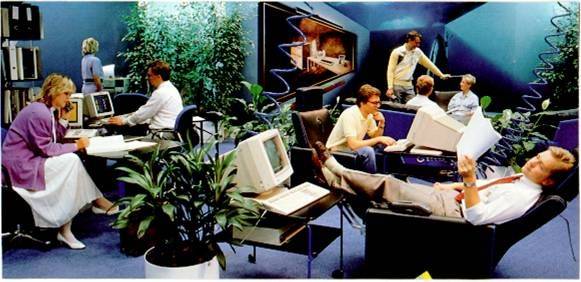 Earlier this month The Once Alternative Workplace Strategies 2018 workplace study was published. This study is the only known longitudinal workplace study and it was recently resurfaced by a group of volunteers to maintain a comparative thread of data on the evolution of workplace thought and practice now going back many years. Unfortunately, the results of this global study demonstrate that a high percentage of companies still see once alternative and now modern workplace strategies as a real estate initiative and not the opportunity to reinvent their businesses in deeper and more transformational ways. Workplace innovation is a litmus test for management quality and leadership. This isn’t about real estate, it’s actually about people and business outcomes.
Earlier this month The Once Alternative Workplace Strategies 2018 workplace study was published. This study is the only known longitudinal workplace study and it was recently resurfaced by a group of volunteers to maintain a comparative thread of data on the evolution of workplace thought and practice now going back many years. Unfortunately, the results of this global study demonstrate that a high percentage of companies still see once alternative and now modern workplace strategies as a real estate initiative and not the opportunity to reinvent their businesses in deeper and more transformational ways. Workplace innovation is a litmus test for management quality and leadership. This isn’t about real estate, it’s actually about people and business outcomes.
The real challenge
It is unfortunate that thirty years (yes thirty years) on from some breathtaking projects in Scandinavia which truly transformed work, how it was done, and how the workplace might best support this, there is still only the sporadic appearance of business leaders who use the workplace to transform their businesses in preparation for the changes that lie ahead. Pictured top is the office of Digital Equipment in Stockholm and Espoo, Finland from the early 1990s (the clothes and tech give it away).
 This, for me, is the real disappointment. We have all become painfully aware of the number of “Fortune 100” companies who within twenty years of their glory years have gone out of business. Their leadership failed to anticipate either shifts in market conditions or disruptive events and they suffered the ultimate price. In this vein, I find myself interviewing both senior and middle management ranks on an almost weekly basis and it never fails to amaze me how few of them spend any time looking forward. Getting them to think beyond the next quarter is often a real challenge.
This, for me, is the real disappointment. We have all become painfully aware of the number of “Fortune 100” companies who within twenty years of their glory years have gone out of business. Their leadership failed to anticipate either shifts in market conditions or disruptive events and they suffered the ultimate price. In this vein, I find myself interviewing both senior and middle management ranks on an almost weekly basis and it never fails to amaze me how few of them spend any time looking forward. Getting them to think beyond the next quarter is often a real challenge.
Inspiration: an opportunity lost
The landmark workplace projects of the late twentieth and early twenty-first centuries might reasonably have been expected to inspire the business world to truly embrace the transformational opportunity and carry it to new heights… but that hasn’t happened. The data in the “The Once Alternative Strategies” survey indicates that the level of sponsorship and leadership by the C-suite is dropping and that real estate organisations are increasingly held responsible for developing and sponsoring their programmes. Rather than seize this opportunity to improve work itself, we seem to be regressing to a more tactical response, albeit flavoured by the focus of the day. First it was the environment, then it was hospitality, then the employee experience of going to work, followed by wellness and so on. Don’t get me wrong, these are all important but they are, in many senses, window dressing… they don’t get to the fundamentals of (though they contribute to) business and human performance.
Workplace strategy versus real estate tactics
To the contrary, in fact, workplace strategy is often hijacked by businesses wishing to save operating cost (by reducing their footprint). The survey data confirms that much of this activity is tactical, not visionary or transformational and unlikely to materially drive either business or human performance to new heights. Furthermore, the sections on measuring success reinforce this. They indicate that the amount of measurement of workplace initiatives overall is dropping, many citing the difficulty of doing so. If I was passionate about business and people driven outcomes I would be increasing measurement, not reducing it.
We know that there are real estate (and HR) organisations that are highly focused on business related outcomes (as opposed to the traditional focus on tactical operational excellence) but we don’t see many of them. One notices, for example, the apparent absence of conceptual positions such as that of a “chief workplace officer” responsible for strategically integrating space, technology, hospitality, anthropology, design thinking, wellness, cognitive science and a host of other tangential disciplines that could potentially contribute to enhanced business performance and/or improved human outcomes. These would be indicators of deeper and more sustained commitments within organisations to bold and systemic re-energising and retooling of their businesses.
What will this same survey show in ten years’ time?
After such an exciting beginning to the whole workplace movement, the logistics of developing the case for change and of transforming of work are proving to be more than most companies can manage. The day-to-day needs of business are syphoning the time and resources away from the effort required to build and sustain strategic change. The survey is full of clues to this stagnation.
But I am an optimist and have always believed that the workplace will end up being a battleground on which the seeds of change will be sown. I am less optimistic that the current generation of business leaders will get us there, but in undertaking various teaching assignments at universities over the past couple of years, I am increasingly hopeful that the new generation of Captains of Industry will blast through the paralysis in search of better business performance and more interesting jobs.
____________________________________
 Chris Hood is Director at Advanced Workplace Associates
Chris Hood is Director at Advanced Workplace Associates














June 22, 2018
Organisations are easily distracted from the task of creating a great workplace strategy
by Chris Hood • Comment, Facilities management, Property, Workplace design
The real challenge
It is unfortunate that thirty years (yes thirty years) on from some breathtaking projects in Scandinavia which truly transformed work, how it was done, and how the workplace might best support this, there is still only the sporadic appearance of business leaders who use the workplace to transform their businesses in preparation for the changes that lie ahead. Pictured top is the office of Digital Equipment in Stockholm and Espoo, Finland from the early 1990s (the clothes and tech give it away).
Inspiration: an opportunity lost
The landmark workplace projects of the late twentieth and early twenty-first centuries might reasonably have been expected to inspire the business world to truly embrace the transformational opportunity and carry it to new heights… but that hasn’t happened. The data in the “The Once Alternative Strategies” survey indicates that the level of sponsorship and leadership by the C-suite is dropping and that real estate organisations are increasingly held responsible for developing and sponsoring their programmes. Rather than seize this opportunity to improve work itself, we seem to be regressing to a more tactical response, albeit flavoured by the focus of the day. First it was the environment, then it was hospitality, then the employee experience of going to work, followed by wellness and so on. Don’t get me wrong, these are all important but they are, in many senses, window dressing… they don’t get to the fundamentals of (though they contribute to) business and human performance.
Workplace strategy versus real estate tactics
To the contrary, in fact, workplace strategy is often hijacked by businesses wishing to save operating cost (by reducing their footprint). The survey data confirms that much of this activity is tactical, not visionary or transformational and unlikely to materially drive either business or human performance to new heights. Furthermore, the sections on measuring success reinforce this. They indicate that the amount of measurement of workplace initiatives overall is dropping, many citing the difficulty of doing so. If I was passionate about business and people driven outcomes I would be increasing measurement, not reducing it.
We know that there are real estate (and HR) organisations that are highly focused on business related outcomes (as opposed to the traditional focus on tactical operational excellence) but we don’t see many of them. One notices, for example, the apparent absence of conceptual positions such as that of a “chief workplace officer” responsible for strategically integrating space, technology, hospitality, anthropology, design thinking, wellness, cognitive science and a host of other tangential disciplines that could potentially contribute to enhanced business performance and/or improved human outcomes. These would be indicators of deeper and more sustained commitments within organisations to bold and systemic re-energising and retooling of their businesses.
What will this same survey show in ten years’ time?
After such an exciting beginning to the whole workplace movement, the logistics of developing the case for change and of transforming of work are proving to be more than most companies can manage. The day-to-day needs of business are syphoning the time and resources away from the effort required to build and sustain strategic change. The survey is full of clues to this stagnation.
But I am an optimist and have always believed that the workplace will end up being a battleground on which the seeds of change will be sown. I am less optimistic that the current generation of business leaders will get us there, but in undertaking various teaching assignments at universities over the past couple of years, I am increasingly hopeful that the new generation of Captains of Industry will blast through the paralysis in search of better business performance and more interesting jobs.
____________________________________